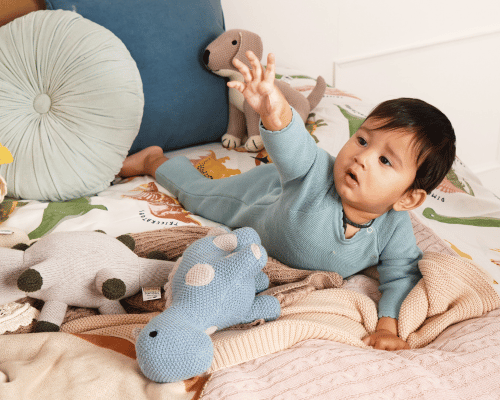When it comes to choosing between cotton fabric toys and polyester fabric toys for babies, there are several factors to consider, including safety, comfort, durability, and environmental impact. Let's compare both options:
Cotton Fabric Toys:
-
Natural and Breathable: Cotton is a natural fiber that is known for its breathability. It allows air to circulate, reducing the risk of overheating and promoting comfort.
-
Hypoallergenic: Cotton is generally hypoallergenic and less likely to cause skin irritation or allergic reactions in babies with sensitive skin.
-
Softness: Cotton fabric is soft and gentle, making it suitable for a baby's delicate skin.
-
Absorbency: Cotton has good absorbent properties, which can be helpful if the toy is accidentally exposed to moisture.
-
Eco-Friendly: Cotton is a renewable and biodegradable resource, making it a more environmentally friendly choice compared to synthetic materials.
Polyester Fabric Toys:
-
Durability: Polyester is a synthetic material that is known for its durability. Polyester fabric toys tend to hold their shape well and can withstand more wear and tear.
-
Ease of Maintenance: Polyester toys are often easier to clean and maintain, as they are less likely to shrink or wrinkle compared to cotton.
-
Color and Print Retention: Polyester fabrics can hold vibrant colors and prints for a longer period, resisting fading and retaining their appearance after multiple washes.
-
Quick Drying: Polyester is quick-drying and doesn't retain moisture as much as cotton, which can be advantageous if the toy gets wet.
-
Allergies and Sensitivities: Some babies might be more sensitive to synthetic materials like polyester, which could potentially cause skin irritation in some cases.
Choosing the Right Option:
-
Safety: Safety is paramount when selecting toys for babies. Ensure that any materials used are non-toxic and meet safety standards.
-
Personal Preference: Consider your personal preference for natural versus synthetic materials, as well as any potential sensitivities your baby may have.
-
Intended Use: Think about how the toy will be used. If it's for cuddling and comfort, a soft cotton toy might be preferred. If it's a toy that will undergo a lot of play and handling, a durable polyester option might be more suitable.
-
Environmental Impact: If you're concerned about the environmental impact, cotton is generally considered more eco-friendly due to its biodegradability.
-
Combination: Many toys combine both materials, using cotton for the soft exterior and polyester for stuffing or structural elements.
Ultimately, the choice between cotton and polyester fabric toys for babies depends on your priorities, the intended use of the toy, and your baby's individual needs and sensitivities. Always ensure that whichever toy you choose meets safety standards and provides the comfort and joy that your little one deserves.


